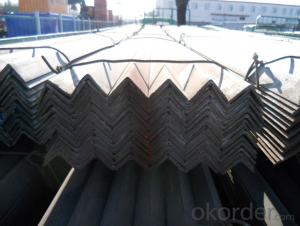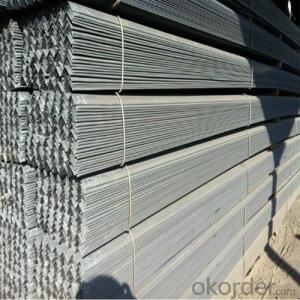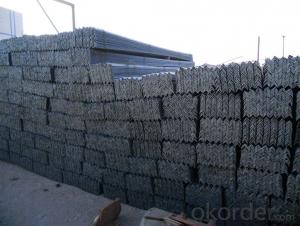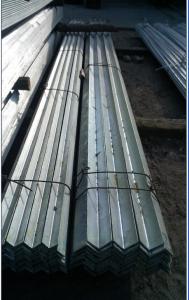GB Q235 Steel Angle with High Quality 50*50mm
- Loading Port:
- Tianjin
- Payment Terms:
- TT or LC
- Min Order Qty:
- 25 m.t
- Supply Capability:
- 10000 m.t/month
OKorder Service Pledge
OKorder Financial Service
You Might Also Like
Specifications of GB Q235 Steel Angle with High Quality 50*50mm:
1.Standards:GB
2.Length:6m, 12m
3.Material:Q235 or equivalent
4.Size:
| Size (mm) | Mass (kg/m) | Size (mm) | Mass (kg/m) |
| 50*50*4 | 3.059 | 50*50*6 | 4.465 |
| 50*50*5 | 3.770 |
Usage & Applications of GB Q235 Steel Angle with High Quality 50*50mm:
Trusses;
Transmission towers;
Telecommunication towers;
Bracing for general structures;
Stiffeners in structural use.
Packaging & Delivery of GB Q235 Steel Angle with High Quality 50*50mm:
1. Transportation: the goods are delivered by truck from mill to loading port, the maximum quantity can be loaded is around 40MTs by each truck. If the order quantity cannot reach the full truck loaded, the transportation cost per ton will be little higher than full load.
2. With bundles and load in 20 feet/40 feet container, or by bulk cargo, also we could do as customer's request.
3. Marks:
Color mark: There will be color marking on both end of the bundle for the cargo delivered by bulk vessel. That makes it easily to distinguish at the destination port.
Tag mark: There will be tag mark tied up on the bundles. The information usually including supplier logo and name, product name, made in China, shipping marks and other information request by the customer.
If loading by container the marking is not needed, but we will prepare it as customers' request.
FAQ:
Q1: Why buy Materials & Equipment from OKorder.com?
A1: All products offered byOKorder.com are carefully selected from China's most reliable manufacturing enterprises. Through its ISO certifications, OKorder.com adheres to the highest standards and a commitment to supply chain safety and customer satisfaction.
Q2: How do we guarantee the quality of our products?
A2: We have established an advanced quality management system which conducts strict quality tests at every step, from raw materials to the final product. At the same time, we provide extensive follow-up service assurances as required.
Q3: How soon can we receive the product after purchase?
A3: Within three days of placing an order, we will arrange production. The shipping date is dependent upon the quatity, how many sizes you want and the plan of production, but is typically 30 to 45 days from the beginning of production.
Images of GB Q235 Steel Angle with High Quality 50*50mm:

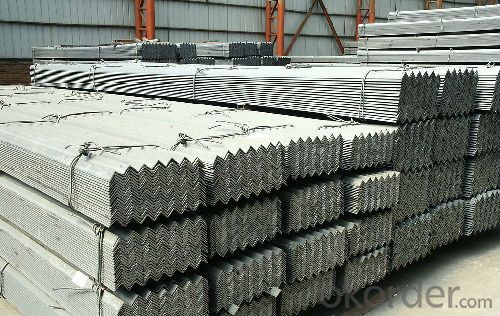
*If you would like to get our price, please inform us the size, standard/material and quantity. Thank you very much for your attention.
- Q: What are the standard lengths for steel angles?
- The standard lengths for steel angles can vary depending on the manufacturer and specific requirements, but common lengths range from 20 feet to 40 feet.
- Q: How do you bend steel angles?
- To bend steel angles, you will need to follow a few steps. Firstly, make sure you have the right tools and equipment, such as a bending machine or a bending brake. These tools are specifically designed to bend metal angles accurately and efficiently. Next, measure and mark the desired bending point on the steel angle. Use a ruler or a measuring tape to ensure accurate measurements. It is essential to have precise markings to achieve the desired angle. After marking the bending point, secure the steel angle tightly in the bending machine or brake. This will prevent any movement or slippage during the bending process. Now, carefully position the bending machine or brake to align with the marked bending point. Adjust the bending angle according to your requirements. This can usually be done by adjusting the clamps or handles on the machine. Once everything is properly aligned, apply gradual pressure to the bending machine or brake. Start with a low pressure and gradually increase it until the steel angle starts bending. Be patient and avoid applying excessive force, as this can cause the angle to deform or break. Continue applying pressure until the desired angle is achieved. Use a protractor or angle measuring tool to ensure accuracy. If necessary, make any minor adjustments to the angle by repositioning the steel angle in the bending machine or brake. Once the bending process is complete, carefully remove the steel angle from the bending machine or brake. Inspect the angle for any imperfections or deformities. If there are any issues, you may need to repeat the bending process or make adjustments to your technique. It is important to note that bending steel angles can be challenging, especially if you are not experienced or do not have the right tools. If you are unsure about the process, it is recommended to seek professional assistance or consult with a metal fabrication expert who can guide you through the bending process safely and accurately.
- Q: Can steel angles be used for staircases or handrails?
- Yes, steel angles can be used for staircases or handrails. Steel angles provide structural support and can be used to create sturdy and durable staircases and handrails. They are commonly used in construction for their strength and versatility.
- Q: What are the common surface treatments for steel angles to enhance corrosion resistance?
- To enhance the corrosion resistance of steel angles, there are various surface treatments commonly employed. These treatments encompass: 1. Galvanization: A highly favored method for safeguarding steel angles against corrosion, galvanization involves the application of a zinc layer through hot-dip galvanizing. This zinc coating acts as a barrier, effectively preventing moisture and corrosive substances from reaching the underlying steel. 2. Painting or Powder Coating: By applying a layer of paint or powder coating to the surface of steel angles, an additional protective layer is established against corrosion. This coating serves as a barrier, shielding the steel from exposure to moisture and other corrosive elements. Particularly useful in applications where aesthetics play a crucial role, this method offers a wide range of color options. 3. Phosphating: Phosphating entails the application of a thin layer of zinc or manganese phosphate to the surface of the steel angle. This treatment forms a protective layer that enhances corrosion resistance by acting as a barrier between the steel and corrosive substances. 4. Chromate Conversion Coating: This process involves immersing the steel angle in a solution containing chromates, resulting in the formation of a thin chromate conversion coating on the surface. This coating acts as a barrier, providing corrosion resistance against moisture and other corrosive elements. 5. Mechanical Finishing: To eliminate existing rust or scale from the surface of the steel angle, mechanical finishing techniques like shot blasting or sandblasting can be employed. This process enhances the adhesion of subsequent coatings and treatments, thereby improving corrosion resistance. It is important to consider that the selection of a surface treatment for steel angles relies on specific applications, environmental conditions, and the desired level of corrosion resistance. Consulting a corrosion specialist or industry professional can aid in determining the most suitable treatment for a given situation.
- Q: Are steel angles suitable for architectural cladding?
- Architectural cladding can indeed utilize steel angles effectively. Due to their robustness, strength, and adaptability, steel angles find wide usage in architectural settings. They offer a sturdy framework capable of supporting a range of cladding materials, including metal panels, glass, and composites. Architects can customize steel angles to suit various sizes and shapes, enabling them to achieve desired aesthetics and design specifications. Moreover, steel angles allow for easy fabrication and installation, making them a cost-efficient option for architectural cladding. Nevertheless, when selecting steel angles for cladding applications, it is crucial to consider factors like corrosion resistance, weather resistance, and maintenance requirements.
- Q: How much is the weight of 40 * 3 angle steel theory?
- Also available models that model is the number of centimeters wide, such as angle 3#. The model does not mean the size of the different edges and sizes of the same model. Therefore, the width, the edge and the thickness of the angle iron should be filled out in the contract and other documents, so as not to be indicated by the model alone. Standard Specification for hot-rolled equal angle iron is 2#-20#.
- Q: Can steel angles be used in temporary or modular structures?
- Yes, steel angles can be used in temporary or modular structures. Steel angles are commonly used in construction due to their strength, versatility, and cost-effectiveness. They are often used to provide structural support and stability in various applications, including temporary or modular structures. Steel angles can be easily cut, welded, and bolted, making them suitable for assembling and disassembling temporary or modular structures. Additionally, steel angles can withstand heavy loads and provide excellent resistance against bending and twisting forces, ensuring the stability and safety of the structure.
- Q: What is the typical thickness tolerance for steel angles?
- The typical thickness tolerance for steel angles can vary depending on the specific manufacturing standards and requirements. In general, the thickness tolerance for steel angles is typically within a range of +/- 0.005 to 0.010 inches (0.13 to 0.25 mm). However, it is important to note that this tolerance can also be influenced by the size and dimensions of the angle. Larger and thicker steel angles may have slightly looser tolerances compared to smaller and thinner angles. It is always recommended to consult the relevant industry standards or specifications to determine the specific thickness tolerance for a particular steel angle.
- Q: How do you calculate the moment of inertia of a steel angle?
- To calculate the moment of inertia of a steel angle, you need to know the dimensions and shape of the angle. The moment of inertia measures an object's resistance to changes in rotation, and it is essential in engineering and physics calculations. The moment of inertia, denoted by I, can be calculated using the formula: I = (b * h^3) / 12 Where: - I is the moment of inertia - b is the base width of the steel angle - h is the height or leg length of the steel angle This formula assumes that the steel angle is a uniform, solid object. If the steel angle has varying dimensions or holes, the calculation becomes more complex and may require additional formulas or numerical methods. It is important to note that the moment of inertia depends on the axis of rotation. The formula mentioned above calculates the moment of inertia about the centroidal axis, which is the axis passing through the center of mass of the angle. If you need to calculate the moment of inertia about a different axis, you may need to use the parallel axis theorem or other advanced techniques. In practice, it is often helpful to consult engineering handbooks or reference materials specific to steel angles as they may provide more detailed formulas or tables that take into account specific design characteristics and dimensions.
- Q: Can steel angles be used for temporary or removable structures?
- Yes, steel angles can be used for temporary or removable structures. Steel angles are versatile and commonly used in construction for various applications, including temporary or removable structures. They are often used as framing elements in scaffolding, support structures, and temporary partitions. Steel angles provide structural support and stability, making them suitable for temporary or removable structures that need to be strong and durable. Additionally, steel angles are easy to assemble and disassemble, allowing for convenient installation and removal of the temporary or removable structure.
Send your message to us
GB Q235 Steel Angle with High Quality 50*50mm
- Loading Port:
- Tianjin
- Payment Terms:
- TT or LC
- Min Order Qty:
- 25 m.t
- Supply Capability:
- 10000 m.t/month
OKorder Service Pledge
OKorder Financial Service
Similar products
Hot products
Hot Searches
Related keywords
